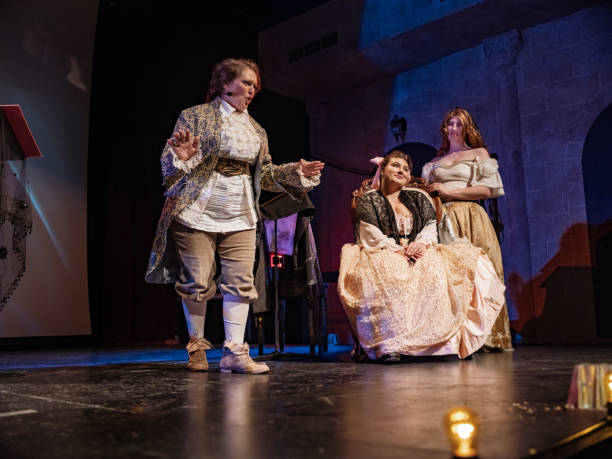Table of Contents
The world of theater opens a gateway to endless creativity and expressive potential, providing a dynamic platform for individuals to explore their artistic brilliance and find their unique voice on stage.
1. The Transformative Power of Theater
Theater can transform individuals by revealing latent talents and creativity. Engaging in theater activities allows performers to explore different characters and scenarios, fostering personal growth. Theater education encourages experimentation with different styles, enhancing self-esteem and confidence. The collaborative nature of theater fosters interpersonal skills and a sense of community, promoting trust, communication, and mutual support. The transformative power lies in reshaping perceptions and inspiring appreciation for the arts.
2. Crafting a Character: The Heart of Theatrical Performance
Character creation is a crucial aspect of theatrical performances, involving an actor&8217;s deep understanding of their character&8217;s motivations, fears, and desires. This process begins with a thorough analysis of the script, revealing layers of complexity. Method acting, a popular technique, encourages actors to connect with their characters on a personal level. Physicality, costume, makeup, and voice modulation also contribute to the authenticity of the character.
3. Expressive Techniques and Artistic Nuances
Expressive techniques in theater are crucial for conveying emotions and narratives in a way that captivates the audience. Theater is inherently a visual and auditory medium, so understanding and mastering these techniques are essential for any successful performance. Physical theater, which emphasizes the use of body movement and gestures, allows performers to communicate emotions and stories without relying solely on spoken dialogue. Through movement workshops and mime exercises, actors can enhance their physical expressiveness, making their performances more dynamic and engaging. Similarly, vocal training is vital for developing a versatile and powerful voice. Exercises in projection, diction, and breath control help actors convey a wide range of emotions and characters. Accent and dialect training can also add authenticity to a performance, especially in period pieces or roles set in specific locales. In addition to these skills, actors must pay close attention to timing and rhythm, both in their individual performances and in the overall pacing of the production. Effective use of pauses, quick dialogue exchanges, and synchronized movements can heighten dramatic tension or comedic effect. Artistic nuances—such as nuanced facial expressions, subtle gestures, and the strategic use of silence—further enrich the performance, creating a more immersive experience for the audience. Together, these expressive techniques and artistic nuances form a comprehensive toolkit that enables actors to bring scripts to life with flair and emotional depth.
4. The Collaborative Spirit: Uniting for a Common Goal
Theater is a collaborative art form that thrives on the collective effort of a diverse group of individuals working toward a shared vision. This includes not only the actors who perform on stage but also directors, set designers, costume designers, lighting technicians, sound engineers, and stage managers, among others. Each role is integral to the final production, and successful theater relies on seamless coordination and teamwork. The director typically serves as the creative leader, shaping the overall vision and guiding the actors and crew through rehearsals and performances. Meanwhile, designers translate that vision into tangible elements, creating sets, costumes, and lighting schemes that enhance the story and atmosphere. Stage managers ensure that every aspect of the production runs smoothly, managing schedules, coordinating between departments, and overseeing the logistical details. Open communication and mutual respect are essential in this collaborative environment. Regular production meetings and feedback sessions allow for the exchange of ideas and ensure that everyone is aligned with the creative goals. Additionally, trust and reliability are critical—each participant must have confidence in their teammates&8217; abilities and commitments. The sense of camaraderie and shared purpose that emerges from this collaborative process can be incredibly rewarding. It not only leads to a successful production but also fosters lasting friendships and professional networks. Ultimately, the spirit of collaboration is what brings the magic of theater to life, creating performances that are greater than the sum of their parts.
5. Lifelong Learning: Theater as a Continuous Journey
Participation in theater is a continuous journey of learning and self-improvement. This journey is characterized by constant discovery, as each new role, script, and production offers fresh challenges and opportunities for growth. One of the key aspects of lifelong learning in theater is versatility. Actors are encouraged to explore a wide range of genres, from classical dramas to contemporary comedies, musicals, and experimental theater. This exposure helps them to develop a broad skill set and adapt to different styles and requirements. Additionally, ongoing training and education play a vital role in an actor’s development. Many performers regularly attend workshops, classes, and seminars to refine their craft and learn new techniques. Studying the works of renowned playwrights, directors, and actors can also provide valuable insights and inspiration. Moreover, practical experience is a crucial component of learning in theater. Each production, whether successful or challenging, offers invaluable lessons. Constructive feedback from directors, peers, and audiences helps actors to identify their strengths and areas for improvement. Embracing these lessons with an open mind and a willingness to grow is essential for continuous progress. The journey of theater also extends beyond the stage, as the skills and experiences gained in theater can enrich other aspects of life. Confidence, communication, empathy, and creativity are just a few of the transferable skills that theater instills. Ultimately, the path of lifelong learning in theater is a fulfilling and enriching experience, driven by a passion for the art and a commitment to personal and artistic growth.
